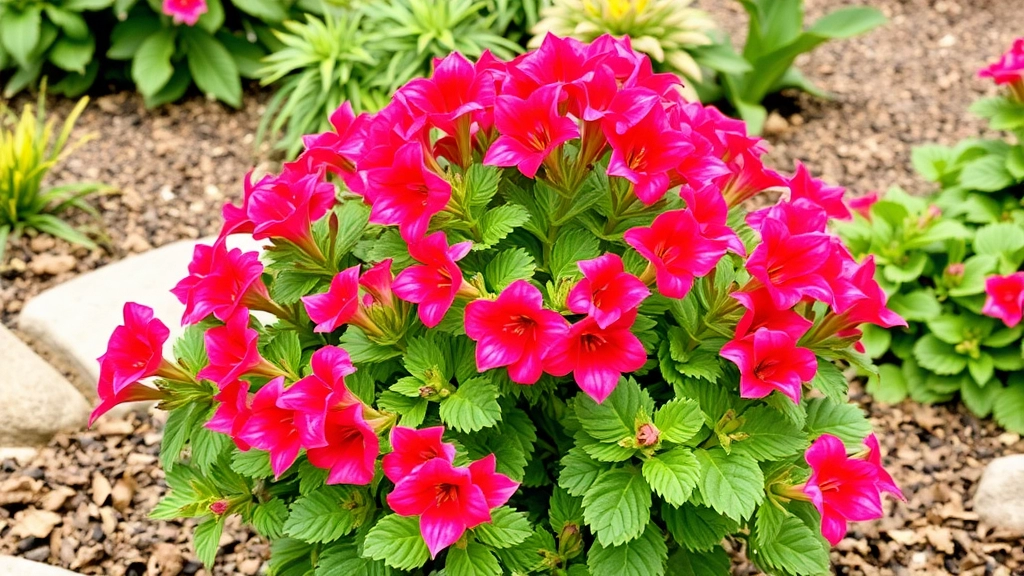Growing Kalanchoe Outdoors in Texas
Growing Kalanchoe outdoors in Texas can be a rewarding experience if you know the right conditions. Texas’s climate, with its hot summers and mild winters, can be perfect for these succulents. To thrive, Kalanchoe needs well-draining soil and moderate watering. Place them in an area where they get plenty of sunlight but also some afternoon shade to protect them from the intense Texas heat.
Choosing the Right Variety
Choosing the right variety of Kalanchoe is crucial. Some types are more heat-tolerant and can handle the Texas sun better. Regularly check for pests and ensure you fertilize them during the growing season for vibrant blooms.
Care Tips for Kalanchoe
- Soil: Well-draining soil is essential.
- Watering: Moderate watering is key.
- Sunlight: Plenty of sunlight with some afternoon shade.
With the right care, your Kalanchoe can flourish in your Texas garden, adding a splash of colour and life to your outdoor space.
Best Climate Conditions for Growing Kalanchoe in Texas
When considering the best climate conditions for growing Kalanchoe in Texas, it’s essential to understand the unique challenges and advantages the region offers. Many gardeners often wonder if Kalanchoe can thrive in the Texas climate, which can be hot and humid in summer and occasionally chilly in winter.
Temperature Tolerance
Kalanchoe thrives in warm temperatures, ideally between 60°F and 85°F (15°C to 29°C).
- Summer: The heat can be beneficial, but temperatures consistently above 100°F (38°C) may stress the plant.
- Winter: Kalanchoe is not frost-tolerant, so temperatures below 40°F (4°C) can be detrimental. Protect your plants during cold snaps. For more details, check out our Kalanchoe Temperature Tolerance Guide.
Humidity Levels
Texas humidity can vary significantly.
- Low Humidity: Kalanchoe prefers moderate humidity levels. If your area is particularly dry, consider misting the leaves occasionally.
- High Humidity: Ensure proper air circulation to prevent fungal diseases.
Rainfall Considerations
Texas experiences varying rainfall throughout the year.
- Drainage: Well-draining soil is crucial. If your garden is prone to standing water, consider raised beds to prevent root rot. Learn more about the best soil for Kalanchoe.
- Watering: During dry spells, Kalanchoe may need supplemental watering, but always allow the soil to dry out between waterings.
Choosing the Right Variety of Kalanchoe for Texas Gardens
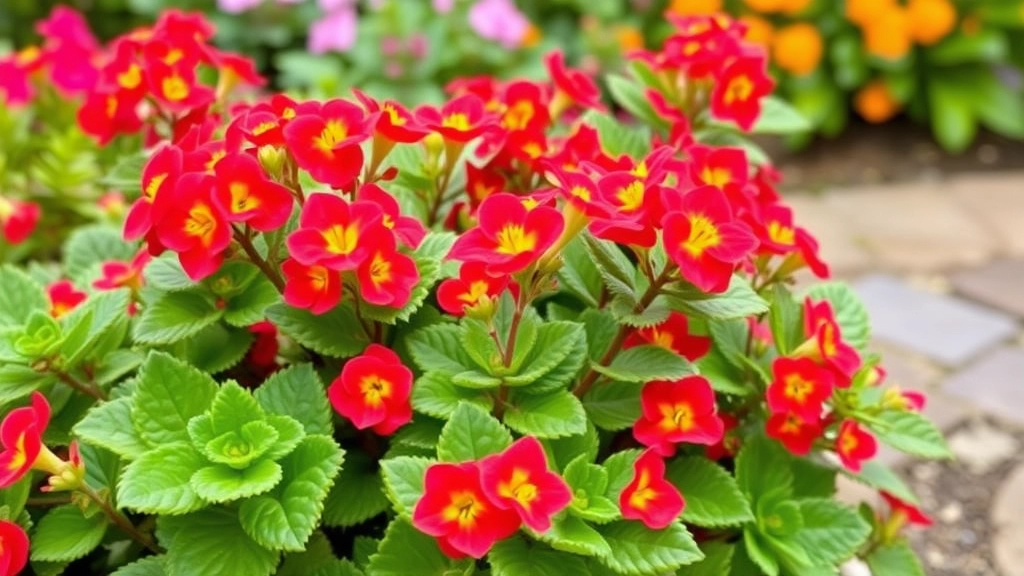
So, you’re excited about adding Kalanchoe to your Texas garden, but which variety should you choose?
It’s a common concern for many gardeners here in the Lone Star State.
Here’s the scoop:
Not all Kalanchoe varieties thrive equally in Texas’s diverse climate.
Some are more heat-tolerant, while others can handle a bit of chill.
Popular Kalanchoe Varieties for Texas
- Kalanchoe blossfeldiana: This one’s a classic! Known for its vibrant blooms, it’s a great choice for those sunny spots in your garden.
- Kalanchoe tomentosa (Panda Plant): With its fuzzy leaves, this beauty adds texture and is fairly drought-resistant.
- Kalanchoe luciae (Flapjack Plant): Its stunning, pancake-like leaves are a showstopper, plus it handles heat like a champ.
Considerations When Choosing
- Sun Tolerance: If your garden gets full sun, opt for varieties like Kalanchoe blossfeldiana.
- Water Needs: Some varieties are more forgiving with drought. Kalanchoe tomentosa is perfect for those who might forget to water occasionally.
- Cold Resistance: If you’re in a cooler part of Texas, you might want to stick with Kalanchoe luciae, which can handle a bit of chill.
Personal Touch
I remember when I first started gardening in Texas. I went with a vibrant Kalanchoe blossfeldiana, and it turned my garden into a colorful oasis.
Choosing the right variety can make all the difference in how your garden looks and feels.
When considering how to plant Kalanchoe outdoors, it’s essential to understand the specific soil and watering needs of this resilient succulent. Many gardeners worry about whether their soil will support healthy growth, but with the right approach, Kalanchoe can thrive beautifully in Texas gardens.
### Soil Requirements
Kalanchoe prefers well-draining soil to prevent root rot, which can be a concern in Texas’s varied climate. Here are key points to consider:
– **Soil Type**: Use a cactus or succulent mix, or create your own by combining regular potting soil with sand or perlite.
– **pH Level**: Aim for a slightly acidic to neutral pH (around 6.0 to 7.0).
– **Drainage**: Ensure your planting area has good drainage. Raised beds or pots with drainage holes work well.
### Watering Guidelines
Watering Kalanchoe requires a balance; too much can lead to rot, while too little can cause wilting. Here’s a simple guide:
– **Frequency**: Water every 2-3 weeks during the growing season (spring and summer) and reduce to once a month in fall and winter.
– **Method**: Water deeply but infrequently. Allow the top inch of soil to dry out before watering again.
– **Signs of Overwatering**: Yellowing leaves or a mushy stem indicate too much water.
By following these soil and watering requirements, you can set your Kalanchoe up for success in your [Texas garden](https://planthq.org/kalanchoe-care-tips-for-thriving-in-texas-climate/).
For more detailed information on how to care for Kalanchoe in different climates, check out our [complete guide](https://planthq.org/caring-for-your-kalanchoe-succulent-a-complete-guide/).
Light and Sun Exposure Needs for Kalanchoe in Texas
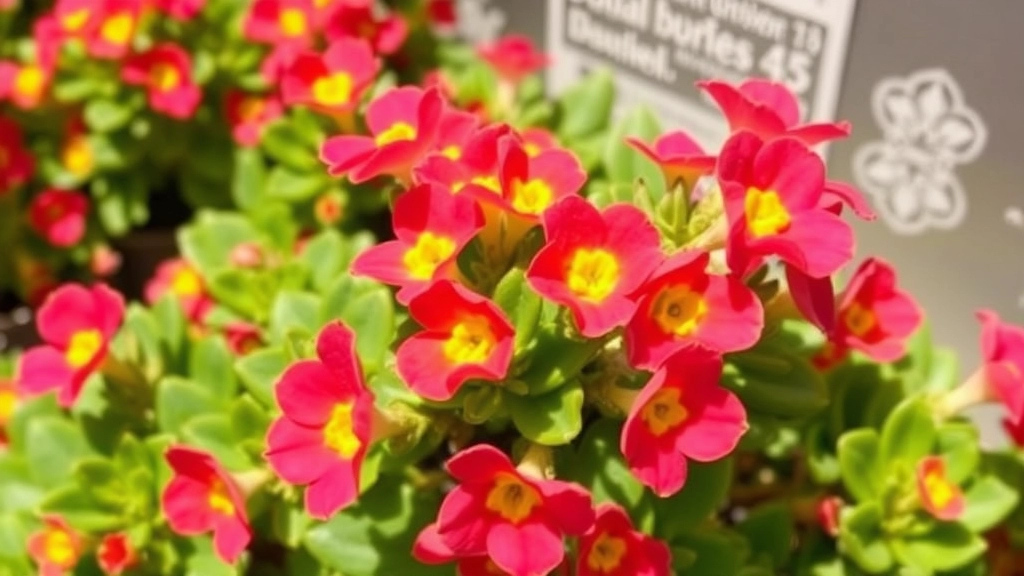
When it comes to growing Kalanchoe in Texas, one of the most pressing concerns is ensuring your plants receive the right amount of light.
Understanding Light Requirements
Kalanchoe thrives in bright, indirect sunlight. However, Texas can present challenges with its intense sun exposure. Here are some key points to consider:
- Ideal Sunlight: Aim for 6 hours of bright, indirect sunlight each day.
- Avoid Harsh Rays: Direct afternoon sun can scorch the leaves, so consider partial shade during peak hours.
- Indoor vs. Outdoor: If planting indoors, place your Kalanchoe near a south or west-facing window for optimal light.
Signs of Improper Light Exposure
It’s essential to monitor your Kalanchoe for signs that it may not be getting enough light:
- Stretched Growth: If your plant appears leggy, it may be reaching for light.
- Fading Colours: Dull or washed-out leaves indicate insufficient light.
- Leaf Drop: Excessive leaf drop can also signal light issues.
Adjusting Light Conditions
If you notice any of these signs, consider adjusting the plant’s location. Here are some tips:
- Rotate Your Plant: Regularly turning your Kalanchoe can ensure even light exposure.
- Use Sheer Curtains: For indoor plants, sheer curtains can help diffuse harsh sunlight while still providing brightness.
Protecting Kalanchoe from Texas Heat and Cold
As we delve into the essential care for Kalanchoe, it’s crucial to address their vulnerability to Texas’s extreme weather conditions.
Understanding Temperature Extremes
Texas is known for its sweltering summers and unpredictable winters. Kalanchoe, being a succulent, thrives in warm climates but can struggle under harsh conditions. Here’s how to protect them:
- Heat Protection:
- Shade: During the peak summer months, provide partial shade to your Kalanchoe. Use garden structures or shade cloths to shield them from the scorching afternoon sun.
- Mulching: Apply a layer of mulch to retain soil moisture and regulate temperature around the roots.
- Watering: Increase watering frequency during hot spells, but ensure the soil drains well to prevent root rot.
- Cold Protection:
- Covering: When temperatures drop below 30°F (-1°C), cover your Kalanchoe with frost cloths or blankets to insulate them.
- Location: If planted outdoors, choose a sheltered spot, such as near a wall, to protect them from cold winds.
- Container Care: For potted Kalanchoe, consider bringing them indoors during winter months or placing them in a garage to shield them from freezing temperatures.
Seasonal Transition Tips
- Spring: As temperatures rise, gradually acclimate your Kalanchoe to more sunlight to prevent sunburn. For more detailed tips, check out our Kalanchoe Flowering Season Blooming Tips and Care Guide.
- Fall: Before the first frost, take preventive measures like covering or relocating your plants. Learn more about seasonal care in our Growing Kalanchoe in Florida: Tips for Thriving Plants.
Seasonal Care Tips for Kalanchoe in Texas: Spring to Winter

So, you’ve got your Kalanchoe thriving in your Texas garden. What’s next? Seasonal care is crucial for keeping your plant healthy and blooming year-round.
Spring: Time for a Fresh Start
- Prune dead leaves: This encourages new growth.
- Repot if needed: If your Kalanchoe is root-bound, it’s time for a bigger pot.
- Fertilize: Use a balanced fertilizer to kickstart growth after winter.
Spring is all about rejuvenation. You’ll see your Kalanchoe starting to bloom, so keep an eye on it!
Summer: Beat the Heat
- Water wisely: Kalanchoe doesn’t like soggy soil. Water when the top inch feels dry.
- Provide shade: During peak heat, a little afternoon shade can protect your plant.
- Watch for pests: Keep an eye out for aphids or mealybugs. A gentle spray of water can help keep them at bay.
Summer can be brutal in Texas, but with a little care, your Kalanchoe can thrive!
Fall: Prepare for Cooler Days
- Reduce watering: As temperatures drop, your Kalanchoe will need less water.
- Check for pests: Fall is a good time to inspect your plant for any lingering pests.
- Fertilize again: A light feeding can help your plant prepare for winter.
Fall is all about transition. Your Kalanchoe might slow down, but it’s not done yet!
Winter: Protect Your Plant
- Bring indoors if needed: If temperatures drop below 50°F, consider moving your Kalanchoe inside.
- Limit watering: Over-watering is a common mistake in winter. Let the soil dry out more than usual.
- Provide indirect light: Your plant still needs some light, but avoid direct sunlight.
Winter can be tough, but with the right care, your Kalanchoe can survive and even thrive.
Common Pests and Diseases in Texas and How to Manage Them
As we delve into caring for Kalanchoe, it’s crucial to address the potential threats these beautiful plants face in Texas gardens. Common pests and diseases can significantly impact their health and blooming potential.
Fertilizing Kalanchoe for Healthy Growth and Blooming
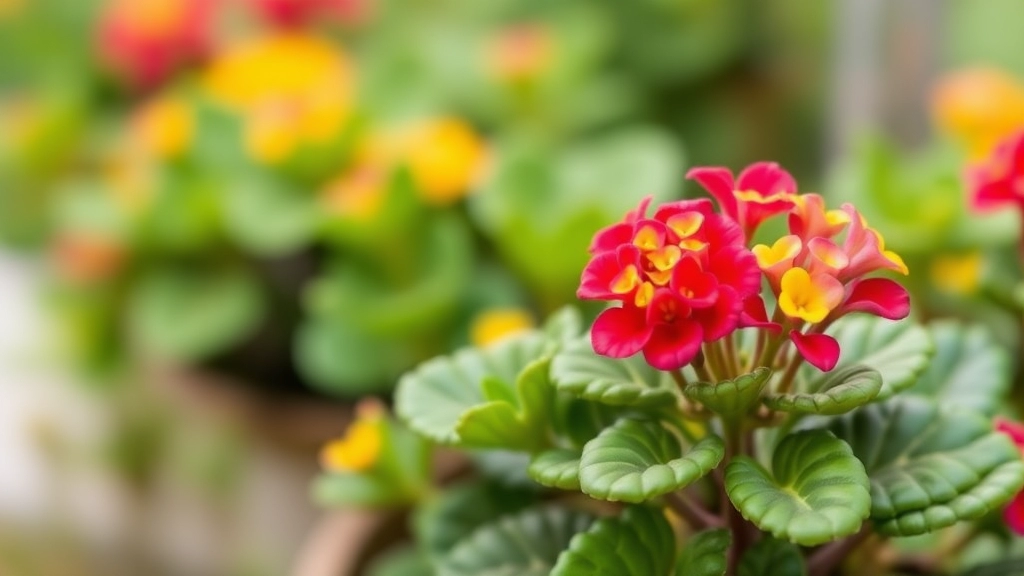
So, you’ve got your Kalanchoe planted, and it’s looking good, but how do you keep that vibrant growth going? Fertilizing is key to ensuring your Kalanchoe thrives and produces those stunning blooms.
Why Fertilize?
You might wonder if fertilizing is really necessary. The answer is a resounding yes!
- Nutrient Boost: Kalanchoe needs nutrients to grow strong and healthy.
- Blooming Power: Proper fertilization encourages more flowers.
When to Fertilize
Timing is everything. Here’s how to nail it:
- Spring Awakening: Start fertilizing in early spring as your Kalanchoe comes out of dormancy.
- Growing Season: Continue every 4-6 weeks during the growing season (spring and summer).
- Fall and Winter: Cut back during the cooler months when growth slows down.
What to Use
Not all fertilizers are created equal. Here’s what to look for:
- Balanced Fertilizer: A balanced 10-10-10 or 20-20-20 fertilizer works wonders.
- Liquid Fertilizer: Liquid options are easy to apply and absorbed quickly.
- Organic Choices: If you prefer the organic route, consider fish emulsion or a cactus mix.
How to Apply
Applying fertilizer doesn’t have to be complicated. Just follow these simple steps:
- Dilute: Always dilute liquid fertilizers to half the recommended strength.
- Water First: Water your Kalanchoe before applying fertilizer to prevent root burn.
- Even Distribution: Pour the mixture evenly around the base, avoiding direct contact with the leaves.
Signs of Over-Fertilization
Keep an eye out for these red flags:
- Yellowing Leaves: Too much fertilizer can cause leaves to yellow.
- Burnt Tips: Leaf tips turning brown? That’s a sign to ease up.
By keeping these tips in mind, you’ll ensure your Kalanchoe stays healthy and blooms beautifully.
Re-blooming Techniques for Outdoor Kalanchoe in Texas
Have you ever wondered how to encourage your Kalanchoe to bloom again after its initial display?
Re-blooming Kalanchoe in Texas requires a bit of attention and care, but it’s absolutely achievable with the right techniques.
Key Techniques for Re-blooming
- Pruning:
- After the blooming period, prune back the spent flowers and any leggy growth.
- This encourages new growth and helps the plant focus its energy on producing fresh blooms. For more detailed tips, check out our pruning guide.
- Light Adjustment:
- Ensure your Kalanchoe receives bright, indirect sunlight.
- If it’s not blooming, consider moving it to a sunnier spot for a few hours each day. Refer to our full sun care tips for optimal results.
- Watering Schedule:
- Allow the soil to dry out between waterings.
- Overwatering can hinder blooming, so stick to a consistent schedule.
- Temperature Control:
- Kalanchoe thrives in warm temperatures.
- Aim for daytime temperatures between 20°C to 24°C and slightly cooler at night.
- Fertilization:
- Use a balanced, water-soluble fertilizer every few weeks during the growing season.
- A high-phosphorus fertilizer can also encourage blooming.
- Dormancy Period:
- After blooming, give your Kalanchoe a rest period of about six weeks with minimal water and no fertilizer.
- This dormancy can help trigger a new blooming cycle.
Best Locations in Your Garden for Planting Kalanchoe
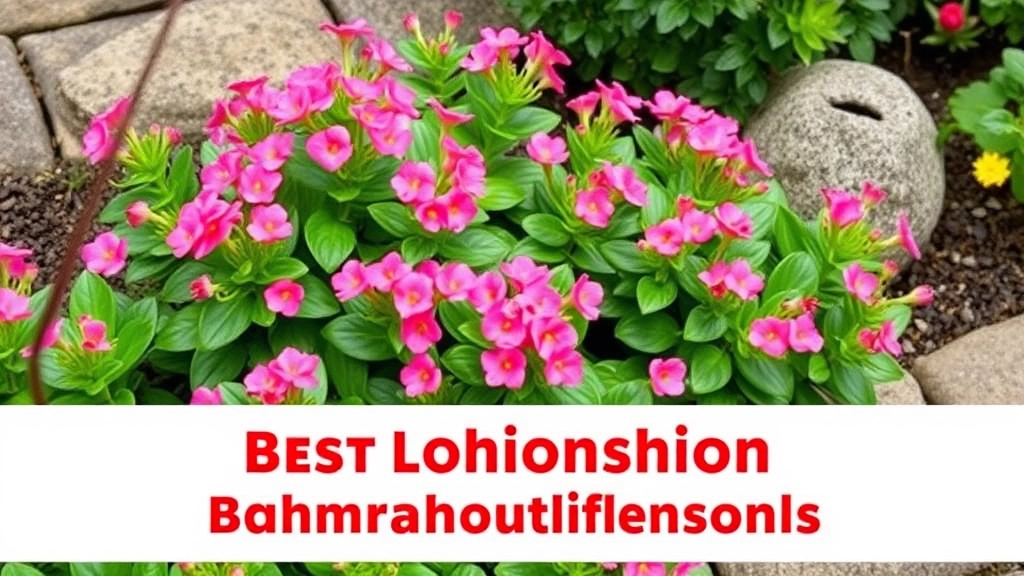
So, you’ve decided to plant Kalanchoe in your Texas garden—great choice! Now, where should you put these beauties? Finding the right spot can make all the difference in how well they thrive.
Sunlight is Key
Kalanchoe loves the sun, so aim for a location that gets:
- Full Sun: Ideally, 6 to 8 hours of direct sunlight daily.
- Partial Shade: If your area gets scorching hot, a little afternoon shade can be beneficial.
Soil Considerations
Kalanchoe isn’t picky, but it does prefer well-draining soil. Here’s what to look for:
- Sandy or Loamy Soil: It helps prevent root rot.
- pH Level: Aim for slightly acidic to neutral (around 6.0 to 7.0).
Elevation Matters
Consider planting Kalanchoe in elevated areas of your garden:
- Raised Beds: These can enhance drainage and keep roots dry.
- Sloped Areas: They naturally drain water away, reducing the risk of soggy soil.
Container Options
If your garden space is limited, don’t fret! Kalanchoe does well in containers too. Just ensure:
- Drainage Holes: Essential to prevent waterlogging.
- Mobility: You can move them around to catch the best light.
Microclimates
Pay attention to microclimates in your garden. Some areas may be warmer or cooler than others due to:
- Nearby Structures: Walls or fences can create sheltered spots.
- Trees: They can provide dappled shade, which is great during peak summer.
How to Propagate and Repot Kalanchoe in Texas Gardens
As we explore the care of Kalanchoe, it’s essential to understand how to propagate and repot these resilient plants. This knowledge will not only help you expand your garden but also ensure your Kalanchoe thrives in Texas’s unique climate.
Propagation Techniques
Propagation is a straightforward process that allows you to create new plants from existing ones. Here are the most effective methods for Kalanchoe:
- Leaf Cuttings:
- Select a healthy leaf from the parent plant.
- Cut the leaf into sections, ensuring each piece has a vein.
- Allow the cuttings to dry for a few days to form a callus.
- Place the cuttings in well-draining soil, and water lightly.
- Stem Cuttings:
- Cut a healthy stem about 4-6 inches long.
- Remove the lower leaves to expose the nodes.
- Let the cut end dry for a few days.
- Plant the stem in soil, ensuring the nodes are buried.
- Offsets:
- Look for small offsets or pups around the base of the plant.
- Gently separate them from the parent plant.
- Plant them in their own pots with well-draining soil.
Repotting Kalanchoe
Repotting is crucial for maintaining healthy growth, especially as your Kalanchoe matures. Here’s a simple guide:
FAQs on Growing Kalanchoe Outdoors in Texas
What are the best Kalanchoe varieties for Texas gardens?
Some of the most popular varieties for Texas include:
- Kalanchoe blossfeldiana: Known for its vibrant blooms, ideal for sunny spots.
- Kalanchoe tomentosa (Panda Plant): Features fuzzy leaves and is drought-resistant.
- Kalanchoe luciae (Flapjack Plant): Has stunning, pancake-like leaves and handles heat well.
How much sunlight does Kalanchoe need in Texas?
Kalanchoe thrives in bright, indirect sunlight. Aim for about 6 hours of bright, indirect sunlight each day. Avoid harsh afternoon sun to prevent leaf scorch.
What should I do if my Kalanchoe shows signs of improper light exposure?
Look for signs like stretched growth, fading colors, and leaf drop. If you notice these, consider rotating your plant or using sheer curtains to diffuse harsh sunlight.
How should I care for Kalanchoe during different seasons in Texas?
- Spring: Prune dead leaves, repot if needed, and fertilize.
- Summer: Water wisely, provide shade during peak heat, and watch for pests.
- Fall: Reduce watering, check for pests, and fertilize lightly.
- Winter: Bring indoors if temperatures drop below 50°F, limit watering, and provide indirect light.
When and how should I fertilize my Kalanchoe?
Start fertilizing in early spring and continue every 4-6 weeks during the growing season. Use a balanced 10-10-10 or 20-20-20 fertilizer, dilute to half strength, and water your plant before applying.
Where is the best location in my garden to plant Kalanchoe?
Kalanchoe prefers full sun but can benefit from partial shade in extremely hot areas. Ensure well-draining soil, and consider elevated areas like raised beds or sloped sections to enhance drainage.
Can I grow Kalanchoe in containers?
Yes, Kalanchoe does well in containers. Ensure the pots have drainage holes to prevent waterlogging, and consider using mobile containers to move them for optimal light exposure.
What are signs of over-fertilization in Kalanchoe?
Watch for yellowing leaves and burnt tips, which indicate too much fertilizer. If you see these signs, reduce the amount and frequency of fertilization.
References
-
Growing Kalanchoe: How To Care For A Kalanchoe Plant
-
10 Kalanchoe Succulent Varieties for Your Indoor Garden
-
Kalanchoe Care: How To Grow Kalanchoe Plants
